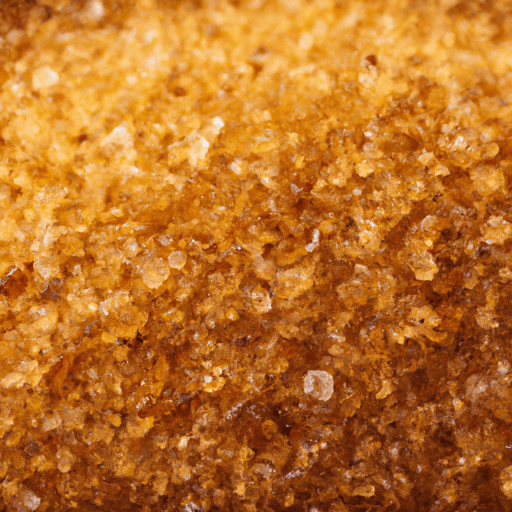The Golden Sweetness of Brown Sugar
If you have a sweet tooth and a love for baking, then brown sugar is an ingredient that should never be absent from your pantry. With its inviting golden hue, tantalizing aroma, and rich, molasses-infused flavor, brown sugar adds a whole new dimension of sweetness to countless recipes. In this blog post, we’ll explore the wonderful world of golden brown sugar, from its taste profile and versatile uses in cooking, to its nutritional value and intriguing history.
The Taste that Delights
The distinct taste of brown sugar can be attributed to its higher molasses content. This natural sweetener has a deep, rich flavor profile that brings warmth and complexity to both sweet and savory dishes. The molasses gives brown sugar a slight hint of butterscotch or caramel, adding a delightful depth of flavor that sets it apart from its white counterpart.
Versatility in the Kitchen
Brown sugar’s unique taste and texture make it an essential ingredient in numerous recipes across various cuisines. It effortlessly elevates baked goods like cookies, cakes, and pies, infusing them with a moistness and softness that are hard to resist. The caramel-like flavor of brown sugar also works wonders in homemade sauces, marinades, and glazes, beautifully balancing out savory or tangy ingredients.
This sweet ingredient isn’t limited to desserts and sauces, though. It harmonizes beautifully with other ingredients in dishes such as baked beans, barbecue sauces, spice rubs, and even glazes for roasted meats. The versatility of brown sugar ensures that it can always find a place in your culinary repertoire.
A Hint of Nutrition
While it’s true that brown sugar still contains calories and should be enjoyed in moderation, it does offer a few nutritional perks when compared to its processed white counterpart. Brown sugar retains some of its natural molasses content, which, in turn, provides a small amount of minerals such as calcium, potassium, and iron. Although these amounts are not substantial, it’s a welcome bonus to know that brown sugar is not entirely devoid of nutritional value.
A Sweet History
The origins of brown sugar can be traced back to the exotic plantations of Southeast Asia. The production of brown sugar began centuries ago, with the sugarcane plant being cultivated extensively in tropical regions. The process involved extracting juice from the sugarcane, boiling it down into syrup, and then allowing the syrup to crystallize. The result was a delightfully golden sugar that soon spread across the globe.
As the popularity of brown sugar grew, different variations emerged around the world. Muscovado sugar from the Philippines, Demerara sugar from Guyana, and Turbinado sugar from the Americas are just a few examples of the diverse types of brown sugar available today. Each variety brings its own unique character to culinary creations, making the world of brown sugar even sweeter.
Sweeten Your Life with Golden Brown Sugar
With its enchanting flavor and ability to enhance a wide range of dishes, golden brown sugar has earned its place as a beloved ingredient in kitchens worldwide. Whether you’re baking delicate cookies, creating a velvety sauce, or adding depth to your barbecued meats, brown sugar has the power to transform and elevate the simplest of recipes. So go ahead, embrace the golden sweetness, and let brown sugar unlock a world of flavors in your cooking adventures.
---
---
Have you tried cooking with brown sugar? Share your favorite recipe in the comments below!
Golden Brown Sugar
Origin and Production: Golden brown sugar is a type of sugar derived from sugarcane or sugar beet. It is produced by refining the juice extracted from these plants, then concentrating and crystallizing it. The golden color is achieved by adding molasses back into the refined sugar during the manufacturing process.
Common Uses: Golden brown sugar is commonly used as a sweetener in various baked goods, desserts, and beverages. It adds a distinct caramel-like flavor and moistness to dishes. It is often used in recipes for cookies, cakes, pies, muffins, sauces, and glazes. Additionally, it can be used to sweeten oatmeal, yogurt, or as a topping for fruits.
Nutritional Benefits: Golden brown sugar contains calories and carbohydrates and provides a quick source of energy. It has a slightly higher mineral content compared to white sugar. However, it is important to note that brown sugar cannot be considered a significant source of essential nutrients.
Unique Properties: Golden brown sugar has a higher moisture content compared to granulated white sugar, which contributes to its unique texture and ability to retain moisture in baked goods. Its strong, distinctive flavor sets it apart from white sugar, making it a popular choice when a richer and more complex taste is desired.
Historical Significance: The production of brown sugar dates back centuries to ancient civilizations such as India and Persia. In the 18th century, brown sugar became popular in Europe due to its distinct flavor. It was traditionally considered a luxury item and was often used in the preparation of extravagant desserts and confections.
Please note that while brown sugar does have a different flavor and color compared to white sugar, it generally does not contain more nutrients. As with any sweetener, it’s important to consume it in moderation as part of a balanced diet.




Use the share button below if you liked it.
It makes me smile, when I see it.